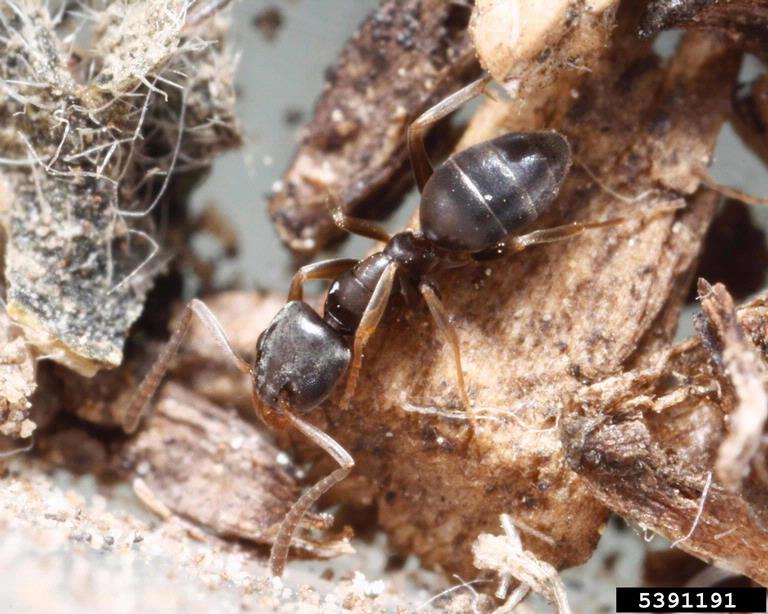 Odorous House Ants - June 19, 2019 Jeff Schalau, Agent, Agriculture & Natural Resources University of Arizona Cooperative Extension, Yavapai County There are over 12,000 species of ants throughout the world. Ants are in the order Hymenoptera. Like their relatives, bees and wasps, they are social insects that go through stages of complete metamorphosis: egg, larva, pupa, and adult. The larvae are immobile and wormlike and are reared by adults. These social insects have castes, reproductive males, reproductive females called queens, and non-reproductive females called workers. This column will focus on the odorous house ant (Tapinoma sessile). Odorous house ant nests often have multiple queens which are the largest in the colony and lay the eggs and sometimes feed and groom the larvae. Workers gather food, tend the larvae, build tunnels, defend the colony, and are the most numerous within the colony. Male ants do not participate in colony activities and their only apparent purpose is to mate with the queens. The males are fed and tended to by the female workers. A single, newly mated queen typically establishes the colony. She lays eggs, feeding the hatched larvae her own metabolized wing muscles and fat bodies until the larvae pupate. Several weeks later, the pupae transform into sterile female adult workers, and the first workers dig their way out of the nest to collect food for themselves, for the queen (who continues to lay eggs), and for subsequent broods of larvae. As numbers increase, new chambers and galleries are added to the nest. After a few years, the colony begins to produce winged male and female ants, which leave the nest to mate and form new colonies. This behavior is called swarming. Odorous house ants are 1/8" to 1/4" inch long, blackish, brown in color, and often invade a home by the thousands following a change in the weather. They are most active when temperatures are between 70 and 86 degrees F. They also have a distinct smell when crushed that some people say is similar to rotten coconut. Odorous house ants often have their nest outside of your house near a shrub or mulched area and enter through a crack in the wall, window, or foundation. Indoors, nests can be found in wall voids, around hot-water pipes and heaters, behind paneling, carpets or beneath the floor. They typically feed on sweets, vegetables, meats, and dead insects. Scout ants (female workers) wander in search of food. Once food is located, she takes a short, direct route home. While returning, she also leaves a detectable trail that other ants can follow. Upon reaching the nest, she alerts her nest mates of the food source and they all follow the trail to the food source. This phenomenon is called trailing. The foremost management strategy should be sanitation. Remove potential food sources by promptly wiping up spills and storing foods in sealed containers. Exclusion is your second line of defense. Follow the trail location and seal the cracks, caulk the seams, and use other materials to limit their entry. This is easier said than done due to the small size of this pest and their large numbers. Preventative measures are rarely 100% effective and insecticide treatment may be necessary. Toxic baits are preferred because the ants transport the insecticide to the nest. The toxins in the baits range from environmentally friendly boric acid to synthetic insecticides. The bait itself can be tricky too. Ants have varied diets that may or may not include sugars, fats, and proteins depending on the state of the brood and other colony needs. To bait successfully, the toxin must be transported back to the colony and ingested by the queen as well as the others. To best manage odorous house ants, homeowners should first correctly identify the ant species, then use a stepwise process to locate nests, decrease populations through baiting, apply perimeter sprays, and possibly directly treat nests. Knowledgeable professionals can also be employed to manage ants. If toxic baits are used, do not use insecticide sprays. This will not allow effective transport of the bait ingredients back to the colony. Follow label directions on any products you decide to use. Additional ant management information is included below. You can follow the Backyard Gardener on Twitter – use the link on the BYG website. If you have other gardening questions, call or email the Master Gardener help line in the Prescott (928-445-6590/prescottmg@gmail.com) or Camp Verde (928-554-8992/verdevalleymg@gmail.com) and be sure to include your name, address and phone number. Find past Backyard Gardener columns or provide feedback at the Backyard Gardener web site: http://cals.arizona.edu/yavapai/anr/hort/byg/. Photos  Odorous house ant (Tapinoma sessile) worker (Joseph Berger, Bugwood.org).
Odorous house ant (Tapinoma sessile) worker (Joseph Berger, Bugwood.org).Additional Resources Odorous House Ants, eXtension articles.extension.org/pages/74638/odorous-house-ants Odorous House Ant, Penn State Extension ento.psu.edu/extension/factsheets/odorous-house-ant |